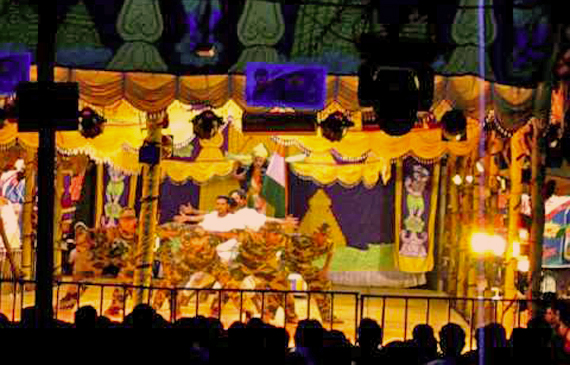Pala, a very popular performance associated with the mixed cult of Satyapir, has wide distribution in Orissa. Its origin goes back to Muslim-mughal period when asimilation of Satya Narayan of Hindu pantheon with Pir of Muhammadanism, brought about a synthetic cult known as ‘Satyapir’. This is an instance to show the inter-change of cultural traits between Hindusim and Islam resulting in subduing to a great extext the intolerance and anticism of Muslims. As a consequence of this fusion the Hindus became the disciples of the Muslim guru or Fakir and adopted worship pattern of some Hidnu deities and vice versa. Satyanarayan is an incarnation of Vishnu, and Pir is an oldman or precept of Muslims who established a religious sect at Persia.
The Fakir considered to be the incarnation of Satyapir, exercised a tremendous influence on the common people of Muslim and Hindu sects. The propitiation of this deity is intended for well-being of the people. A story with regard to the origin of Satyapir is recorded in the Pala of Krishna Haridas. According to this interesting story,
king Maidanb’s virgin daughter Sandhyabati while taking a dip in the river, saw a flower floating and by smelling it she became pregnant. When her parents were aware of the fact, they took it a serious offence and drove her away. Under orders from Satyapir still in the womb, Hanila built a palace for Sandhyabati where she gave birth to a ball of bloody flesh.
She threw it away into the river. A she-tortoise swallowed it up, gave birth to Satyapir and went to heaven after death. Kusaleswar, the Purohit of Maidanab brought him up with care. One day while taking a walk on the bank of the river Nur, Satyapir found a manuscript of Koran. The Brahmin asked him to keep that book in its former place as it should not be touched by a sacred Brahmin. The boy argued and concluded that there was no difference between a Purana and Koran. Hinduism and Islam are not hostile to each other.
The cult of Satyapir is so popular in Orissan culture, the Puranas and popular literature profusely mention it and the supernatural powers endowed on the deity.We have two types of Pala in Orissa – the Baithaki (sitting) and the Thia (standing). The Thia pala is taken to be the developed form of Danda Nata. The group of performers consisting of six persons including the Bayak, or the drummer (playing on the Mrudanga) and
the chief singer known as Gayaka. The side singers with their cymbals sing and dance explaining the meaning of the verses to the audience. The performance begins with invocation to Satyanarayan followed by the story of Puranas or epics embellished with poems of different poets. The Pala songs are the compositions of the local poets and recited in the appropriate places during the performance.
In a Pala performance, songs of various types in different styles redominate the dance which on the other hand, is the expression of simple rhythm to the tune of music. Pala is normally ritualistic in character and is performed on the occasion of worship of Satyanarayan but now-a-days it is performed on important festive occasions. The performers, be it in an urban area or in the folk area, draws a large audience. The interesting theme of Pala, the lyrical diction of the poets exhibited in a charming manner in melodious voice, the songs of humour with the use of local dialects, the depiction of humorous story, the skillful play of mridanga, the charming and colourful dress of Gayak and palias make the audience spellbound.
 Destination Odisha
Destination Odisha



